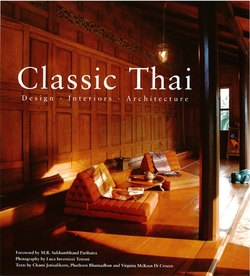Читать книгу Classic Thai - Chami Jotisalikorn - Страница 5
На сайте Литреса книга снята с продажи.
ОглавлениеInterior of the library of Wat Rakang, Thonburi, which originally was the house of King Rama I. The building has been restored by the noted thai artist Fua Horapitak.
Foreword by M.R. Sukhumbhand Paribatra
When one sees a classic Thai object, be it a necklace or a ceramic jar, a manuscript cabinet or a stucco temple motif, the item immediately distinguishes itself as being uniquely Thai. This is in great part due to its decoration, with floral or vegetal designs, the tapering shape and the mastery of craftsmanship, utilizing skills and styles that have been handed down over centuries, if not millennia.
Similarly, when one visits a Thai palace, temple compound or typical classic Thai house, there is no question as to its origin and heritage. Be it the glittering roofs of Bangkok's Grand Palace, the soaring silhouette of a wooden house on stilts, or a towering bell-shaped chedi rising from the central plains: they all reflect an unmistakably Thai image.
However, this immediately identifiable 'Thai style' is not a static phenomenon. This book traces its evolution, from its 13th-century Khmer heritage, through centuries of development and adaptation, to the present day. From the ancient capitals of Sukhothai and Ayutthaya, to the northern Lan Na Kingdom and today's Ratanakosin era, the influences from Siam's surrounding neighbours are apparent. Shapes, lines and motifs from India, Sri Lanka, the Mon people, Myanmar (Burma), China and even classical Europe, are now constant features of the Thai architectural landscape. Somehow, the Thais have managed to absorb many different styles, adapt them to their own use, and then re-export them, in their new Thai-style incarnation, oftentimes back to the people from whence they came.
Thai belief in Buddhism and the Thais' veneration of their monarchy are embedded in the arts. Over the centuries, artists, architects and artisans have built countless palaces and temples, to venerate both the Buddha and the King. Similarly, Buddha images have always held pride of place in the monasteries as the centre of the Thai religious universe, and because of the tradition of making merit, such images, along with other temple accoutrements (manuscript cabinets, altars, pulpits, ceremonial containers and so on) have flourished. Similarly, items crafted for wealthy patrons, in the form of jewelry, furniture, ceramics, textiles and more, have played an important role. This publication offers an in-depth analysis of this tradition of design and craftsmanship.
Moreover, recently, it has become popular, amongst both Thais and foreign residents, to try to preserve and emulate this tradition in domestic architecture and interiors. One of the major features of classic Thai architecture is its transportability. Built entirely from wooden panels, domestic houses lend themselves to being dismantled, moved to a new site, and reassembled or rebuilt with adaptation.
It is an increasingly common sight to see such houses in a metropolitan setting, and to witness typical Thai items used in their interior decoration. Whereas once traditional Thai houses would have had reed matting, cushions and perhaps a tang (a low square or rectangular seat/table) or two, today they are furnished with vernacular panache. Manuscript cabinets double up as television repositories, sofas are upholstered in Thai silk, and parts of gables may be hung on the walls as decoration. Similarly, banners once reserved for the temple, are displayed as modern-day objets d'art. This book showcases a variety of such Thai-style houses adapted for modern-day use.
Opening with a chapter on the classic Thai house, then following through with an in-depth analysis of the country's prime religious and royal sites, and ending with a cornucopia of Thailand's arts and crafts, Classic Thai is an inspiring addition to the ongoing analysis of Thai style.
